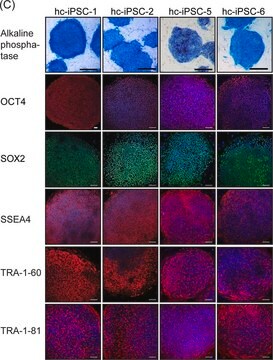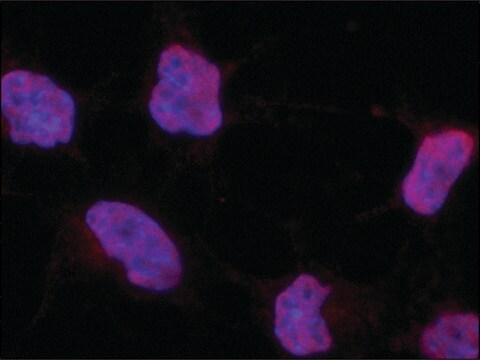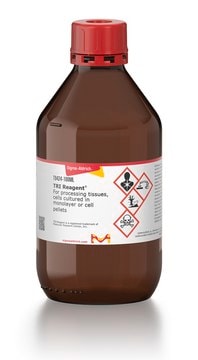MAB4401
Anti-Oct-4 Antibody, clone 10H11.2
clone 10H11.2, Chemicon®, from mouse
Synonyme(s) :
Octamer-binding transcription factor 3, POU class 5 homeobox 1, POU domain class 5, transcription factor 1, POU domain, class 5, transcription factor 1, POU-type homeodomain-containing DNA-binding protein, octamer-binding transcription factor-3
About This Item
Produits recommandés
Source biologique
mouse
Forme d'anticorps
purified antibody
Clone
10H11.2, monoclonal
Espèces réactives
human
Fabricant/nom de marque
Chemicon®
Technique(s)
ELISA: suitable
flow cytometry: suitable
immunocytochemistry: suitable
western blot: suitable
Entrée
sample type induced pluripotent stem cell(s)
sample type: human embryonic stem cell(s)
Isotype
IgG1
Numéro d'accès NCBI
Numéro d'accès UniProt
Conditions d'expédition
wet ice
Modification post-traductionnelle de la cible
unmodified
Informations sur le gène
human ... POU5F1(5460)
Description générale
Spécificité
Application
ELISA: A previous lot of this antibody was used in ELISA.
Immunocytochemistry: A previous lot of this antibody was used in IC. H9 cells in culture on a mouse embronic fibroblast feeder layer were labeled by a standard indirect IF protocol. Oct-4 labelling in green, DAPI in blue, & SSEA-3 (MAB4303 in red).
Optimal working dilutions must be determined by the end user.
Qualité
Western Blotting: 1:500 dilution of this antibody detected Oct-4 on 10 µg of mouse P1 brain lysates
Description de la cible
Forme physique
Remarque sur l'analyse
Human embryonic stem cell lysate.
Autres remarques
Informations légales
En option
Code de la classe de stockage
12 - Non Combustible Liquids
Classe de danger pour l'eau (WGK)
WGK 2
Point d'éclair (°C)
Not applicable
Certificats d'analyse (COA)
Recherchez un Certificats d'analyse (COA) en saisissant le numéro de lot du produit. Les numéros de lot figurent sur l'étiquette du produit après les mots "Lot" ou "Batch".
Déjà en possession de ce produit ?
Retrouvez la documentation relative aux produits que vous avez récemment achetés dans la Bibliothèque de documents.
Articles
Skip weekend feedings. Defined serum-free and feeder-free expansion media for human pluripotent stem cells (ES and iPS cells). See publications and protocols.
Fibroblast growth factors (FGFs) are secreted glycoproteins that regulate several fundamental developmental pathways and help regulate mesoderm and ectoderm patterning in the early embryonic development.
The Simplicon™ RNA Reprogramming Technology is a next generation reprogramming system that uses a single synthetic, polycistronic self-replicating RNA strand engineered to mimic cellular RNA to generate human iPS cells.
Human iPSC neural differentiation media and protocols used to generate neural stem cells, neurons and glial cell types.
Notre équipe de scientifiques dispose d'une expérience dans tous les secteurs de la recherche, notamment en sciences de la vie, science des matériaux, synthèse chimique, chromatographie, analyse et dans de nombreux autres domaines..
Contacter notre Service technique![Anti-OCT-4 [POU5F1] Antibody, clone 7F9.2 clone 7F9.2, from mouse](/deepweb/assets/sigmaaldrich/product/images/307/874/7354f72d-80ee-40a5-b7fa-0590fe6784cc/640/7354f72d-80ee-40a5-b7fa-0590fe6784cc.jpg)








